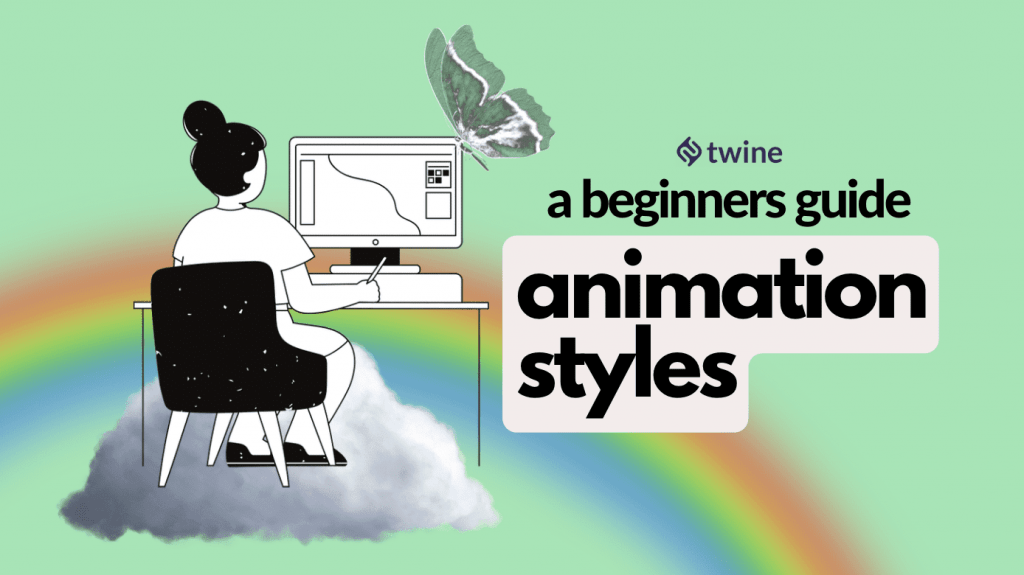
For more Creative Tools, check out the Business Toolkit…
If you’re looking to create an animated video, one of the first things you’ll have to decide on is the animation styles you’d like to incorporate.
Here’s the thing:
There are so many. Out of the hundreds of different animation styles, it can be difficult to decide which one is best suited to your project.
Having seen thousands of animation projects completed through our platform, we’re here to help you get to the bottom of this.
In this article, we’ll be breaking down the different animation styles out there. We’ll take a look at how they differ, and which medium each style is best suited to. If you’re looking to set a budget for a particular style of animation, it’s also well worth checking out our adjacent guide on setting a budget for animation.
Ready? Let’s get into it!
Post up an animation project brief on our freelance marketplace and top-quality animators will contact you with their rates.
2D Vs. 3D
Most forms of animation can be grouped into either 2D animation or 3D animation. Here’s the difference between the two:
2D animation exists in a two-dimensional format. Simple, right? This is where it appears to have length and breadth, but no depth. It can be either hand drawn or computer-generated.

3D animation exists in a three-dimensional universe, meaning it contains the depth that 2D animation misses. Unlike 2D animation, it can only be made using computer-generated imagery.

2D animation is built upon well-designed imagery, making it a far-more creative style of animation. 3D animation has a much heavier focus on mathematics and physics, which is required to create a realistic-looking product.
As a result, 3D animation is often more expensive to produce.
To keep it simple, here’s a quick comparison of the main differences between 2D and 3D animation:
2D Animation | 3D Animation |
Can be either hand-drawn or computer-generated | Can only be computer-generated |
Cheaper & quicker to produce | More expensive and time-consuming to produce |
Less realistic | More realistic |
Less dynamic | More dynamic |
Main Animation Styles
Anime

Anime refers to any type of animation that’s produced in Japan, regardless of technique or style. Although incredibly diverse, it differs from Western animation by primarily targeting adult audiences (whereas most Western animation is made for children).
Anime places significant emphasis on character emotion & personality, often featuring highly-immersive and emotionally-complex storylines.
Anime storylines are generally slow-burning, with the plot slowly unfolding over the course of dozens of episodes.
Anime has built up an incredibly loyal fandom, with dedicated cosplay and anime conventions taking place around the world each year.
Key features:
- Exaggerated physical features
- Emotionally-complex characters
- Complex, slow-burning storylines
- Adult audience
- Vivid colors
Commonly used for:
- Web series
- Comic books
- Feature films
Example – Death Note (2006):
Disney

Disney is a world-leading animation brand that’s famous for its feature films and animated shorts.
As one of the longest-running and commercially successful animation brands, it created many techniques and processes that are now standard practice in traditional animation. These include:
- Storyboarding
- Three-strip coloring
- Use of multiplane cameras
Disney is well-known for its emphasis on family-friendly storylines. Often, their films are set within a magical universe. This is supplemented by a set of core themes that are present in almost every production, including love and loyalty.
Disney productions are also well-known for their emphasis on music, with many characters being associated with a distinct musical theme.
Key features:
- Family-friendly
- Themes of love, magic, and loyalty
- Fully-scored Western soundtrack
- Emphasis on magic
Commonly used for:
- Feature films
- Cartoons
Example – The Lion King (1994):
Vintage Animation Styles
Traditional Animation

Traditional Animation (also known as frame-by-frame animation) refers to animation that has been hand-drawn on paper. It served as the leading form of animation throughout most of the 20th century.
Traditional animation works by having an animator draw each frame by hand, with each frame being slightly different from the previous one.
The individual drawings are then placed into plastic cels and photographed in order. The images are then played back at high speed, giving the illusion of movement.
Throughout the 20th century, traditional animation was primarily used for both cartoons and feature-length films. Although still in existence, traditional animation has subsequently been overtaken by digital animation as a means of producing 2D animation.
Key features:
- Hand-drawn appearance
- Exaggerated movements
- Vivid color
Commonly used for:
- Feature films
- Cartoons
Example – Pinocchio (1940):
Stop Motion Animation
Stop motion animation is an animation technique used to give physical, inanimate objects the illusion of movement.
This is done by incrementally moving the objects in-between frames. The frames are then played back in rapid chronological order, creating a continuous motion sequence.
Stop motion serves as one of the earliest forms of commercial animation, rising to prominence in the late 19th century with the advent of silent films.
Although stop motion animation can be made using any type of inanimate object, plasticine character models are one of the more popular choices due to their ease of movement. The use of plasticine characters makes up a closely-related style called Claymation.
Although still used for animated shorts and feature-length films, stop motion animation is now a commonly-used technique for marketing/explainer videos.
Key features:
- Rapid/inconsistent movement
- Presence of puppets or clay figures
Commonly used for:
- Feature films
- Cartoons
- Explainer/marketing videos
Example – Wallace & Gromit: A Grand Day Out (1989):
Rotoscope Animation
Rotoscoping was invented in 1917 by animation pioneer Max Fleischer, who’s known for working on productions such as Betty Boop. The technique quickly rose to dominance in the industry, with Disney famously using it to produce Snow White & The Seven Dwarfs
Rotoscope Animation is where animators trace live-action footage frame-by-frame. This is done to produce realistic-looking movements and save time during hand-drawn animation.
The technique began to fall out of popularity with the advent of digital 2D animation in the late 20th century.
Key features:
- 2D style
- Realistic movement
Commonly used for:
- Feature films
- Cartoons
Example – Snow White And The Seven Dwarfs (1937):
Modern Animation Styles
Digital Animation
Digital Animation (also known as Computer Generated Imagery) is any type of animation that’s created using computer software. It’s currently the most widely-used form of animation for feature films, animated shorts, video games, and explainer videos.
Having gradually developed since the 1940s, digital animation replaced traditional animation as the industry standard in the early 1990s, with Pixar’s Toy Story (1995) being the first feature-length digitally-animated film.
Digital animation encompasses a wide variety of styles, including:
- 2D
- 3D
- Cutout
- Typography
- Motion capture
Digital animation is highly-affordable and can be turned around on a relatively short timescale, making it a popular choice amongst businesses for either marketing material or training videos.
Key features:
- Highly-versatile
- Computer-generated
- Realistic-looking
Commonly used for:
- Feature films
- Animated shorts
- Web series
- Explainer videos
Example – Toy Story (1995):
Motion Graphics

Motion Graphics serve as a middle ground between animation and graphic design.
They’re essentially graphic designs with animated movement, which adds a sense of flare to what would otherwise be a static design.
- To convey information (e.g. explainer video)
- To enhance the look and feel of a design (e.g. animated logo)
Therefore, motion graphics are most commonly used by businesses for branding, promotional, and/or informational purposes.
Examples of motion graphics include:
- Explainer videos
- Animated logos
- Lyric videos
- Website graphics
Key features:
- Simplistic
- Information-driven (rather than narrative-driven)
- Business-focused
Commonly used for:
- Marketing material
- Branding
- Social media content
Example – How Does Twine Work? (2017):
Virtual Reality Animation

Virtual Reality Animation is an animation that takes place in a three-dimensional digital environment that can be explored by a person. This makes for a highly-immersive and interactive experience.
Having begun development in the 1970s, it entered the commercial animation market in 1991, with Sega releasing a VR headset for the mega drive console.
Although commonly used for feature films and video games, virtual reality animation is commonly used to create marketing material for businesses, such as this VR catwalk experience by Topshop:
Key features:
- 3D
- Highly immersive
- Responsive
Commonly used for:
- Video games
- Marketing/demonstrative material
Wrapping up
So, there you have it! An all-encompassing guide on the top animation styles. There are many layers to this design style, so finding one that suits you should be easy.
Ready to hire? Our marketplace of over 410,000 diverse freelancers has the skills and expertise needed to skyrocket your business. From marketers to designers, copywriters to SEO experts – browse the talented bunch here!






